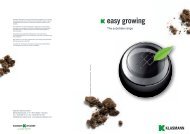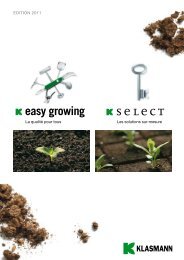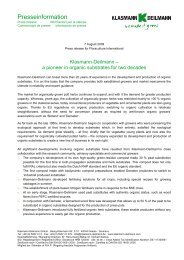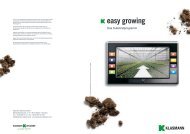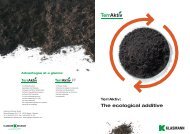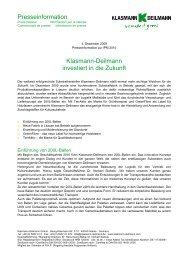Brochure on sustainability - Klasmann Deilmann
Brochure on sustainability - Klasmann Deilmann
Brochure on sustainability - Klasmann Deilmann
You also want an ePaper? Increase the reach of your titles
YUMPU automatically turns print PDFs into web optimized ePapers that Google loves.
Worldwide, however, more peat moss grows than is extracted. There<br />
is an annual gain of around two billi<strong>on</strong> cubic metres of Sphagnum<br />
in pristine peatlands, whereas some 100 milli<strong>on</strong> cubic metres of peat<br />
are harvested annually for commercial purposes – a ratio of 20:1.<br />
(Source: www.bth-<strong>on</strong>line.org)<br />
The extracti<strong>on</strong> of peat affects the ‘ecology’ pillar. Peat producti<strong>on</strong> uses<br />
natural resources, although this takes place solely in areas that were,<br />
under completely different circumstances, drained some decades ago.<br />
Peat extracti<strong>on</strong> is prohibited today in pristine bogland.<br />
Impact <strong>on</strong> the climate<br />
For some years now, peatlands, peat extracti<strong>on</strong> areas and peat<br />
producti<strong>on</strong> have been looked at in terms of greenhouse emissi<strong>on</strong>s.<br />
Intact boglands store carb<strong>on</strong> dioxide (CO2) and release the greenhouse<br />
gases methane (CH4) and nitrous oxide (N2O). Drained peatlands<br />
release the previously stored (CO2). Of the total annual emissi<strong>on</strong>s in<br />
Germany, 0.2 % result from peat producti<strong>on</strong>. Restored extracti<strong>on</strong> areas<br />
can reassume the functi<strong>on</strong> of carb<strong>on</strong> sinks. (Source: IVG-Präsentati<strong>on</strong><br />
“Fakten Torf”)<br />
The questi<strong>on</strong> of the impact of peat extracti<strong>on</strong> <strong>on</strong> climate touches <strong>on</strong><br />
the ‘ecology’ pillar of <strong>sustainability</strong>. This debate centres chiefly around<br />
greenhouse gases that are released through peat producti<strong>on</strong>. The fact<br />
that pristine peatlands also give off greenhouse gases is often ignored<br />
in the debate, as these emissi<strong>on</strong>s are not human in origin. Nevertheless,<br />
all aspects need to be borne in mind. Pristine peat areas are not <strong>on</strong>ly<br />
climate-friendly: they also emit greenhouse gases. This is not to gloss<br />
over the emissi<strong>on</strong>s caused by peat extracti<strong>on</strong>, but it does help to put<br />
them in c<strong>on</strong>text.<br />
24 25



